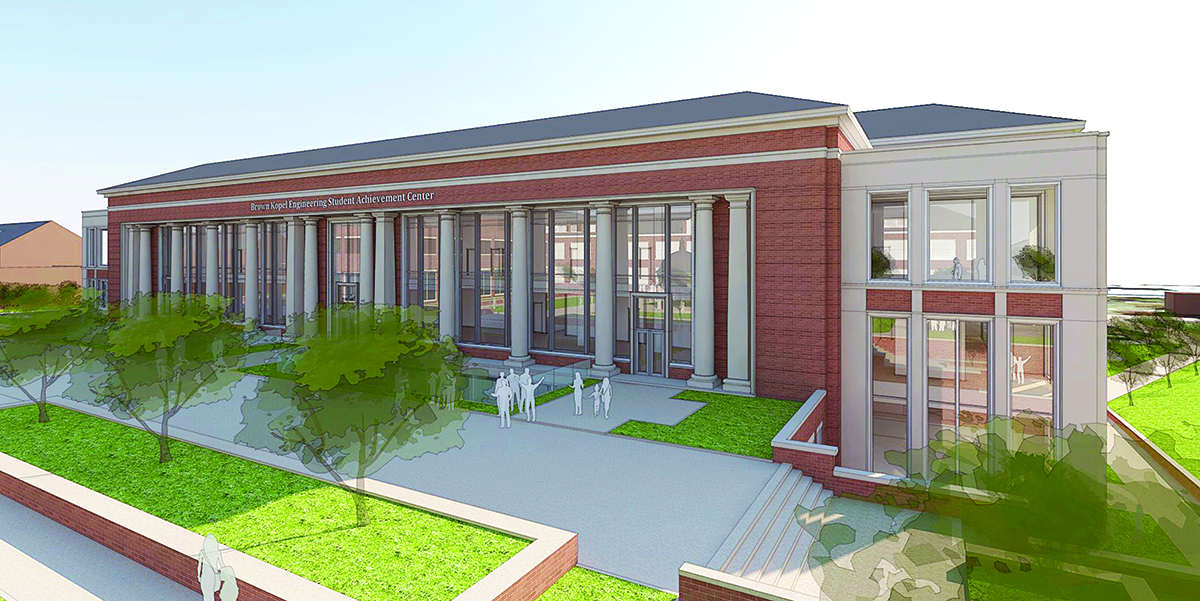With a share of the largest gift in the university’s history, the college is constructing a state-of-the-art, comprehensive student achievement center thanks to the generosity of John and Rosemary Brown, both 1957 graduates. Construction of the Brown-Kopel Engineering Student Achievement Center is made possible thanks to a $30 million gift from the Browns, part of an overall $57 million gift that was announced in April 2015 at the Because This is Auburn – A Campaign for Auburn University kickoff event.
Building for the future
 Site preparation for the $40 million project, made possible by the Brown’s gift and nearly $10 million in university funding, began December 2016 with the demolition of the Engineering Shops and L Building. Construction is anticipated to be completed by spring 2019. This project will complete more than $60 million in new construction and renovation on the engineering campus.
Site preparation for the $40 million project, made possible by the Brown’s gift and nearly $10 million in university funding, began December 2016 with the demolition of the Engineering Shops and L Building. Construction is anticipated to be completed by spring 2019. This project will complete more than $60 million in new construction and renovation on the engineering campus.
 Located in the heart of campus, the center will specifically address students’ professional and academic needs, providing one of the most comprehensive, active-learning environments in the country. In cohesion with the college’s vision to provide the best student-centered engineering educational experience in America, the center will also create greater opportunities for collaboration among faculty members and students, creating a sense of home
Located in the heart of campus, the center will specifically address students’ professional and academic needs, providing one of the most comprehensive, active-learning environments in the country. In cohesion with the college’s vision to provide the best student-centered engineering educational experience in America, the center will also create greater opportunities for collaboration among faculty members and students, creating a sense of home
within the engineering campus.
 Designed to serve students from all engineering disciplines, this center will incorporate high-contact initiatives through student recruitment, curriculum advising, career mentoring and placement, tutoring, international experiences, corporate relations and professional development.
Designed to serve students from all engineering disciplines, this center will incorporate high-contact initiatives through student recruitment, curriculum advising, career mentoring and placement, tutoring, international experiences, corporate relations and professional development.
The ins and outs
The first floor of the building will include a design and innovation center, which will consist of student maker spaces, laboratories, shops, project incubators, study rooms, a flexible classroom, computer labs and more, while also serving as the home for engineering student organizations. The second floor will house a tutoring and learning center, academic advising center, student recruitment center, professional development and corporate relations center, the Alabama Power Academic Excellence Program and offices for support staff. The third floor will incorporate ample, spacious student study areas with large-group and small-group study rooms, two large flexible classrooms, boardrooms, conference rooms and ballrooms all outfitted with the latest smart technologies.
With 175 indoor and outdoor spaces, the Brown-Kopel Engineering Student Achievement Center is designed to provide the perfect environment to assist the college starting with recruiting the best and brightest to Auburn and then supporting those students from freshman year through graduation. This center will most often be the first building prospective students enter when they visit the college and the last one they leave as they embark on a successful carer as an Auburn Engineer.

A lasting legacy
John Brown and Rosemary Kopel Brown graduated from Auburn University in 1957 with bachelor’s degrees in chemical engineering and chemistry, respectively.
John retired from Stryker, a global-leading medical technology company, as its president, CEO and chairman of the board. There, he took the company public and increased revenue from $17 million in 1976 to $10 billion today. Rosemary retired as a mathematics teacher, a position she held for almost 30 years, impacting hundreds of students along the way.
The Browns have remained dedicated and committed
partners with Auburn University, supporting scholarships and programs within engineering, sciences and mathematics, performing arts and veterinary medicine for nearly four decades. The Browns have also endowed an eminent scholar chair in the Department of Chemical Engineering and the first endowed eminent scholar chair in the College of Sciences and Mathematics.
They are members of the College of Engineering’s Ginn and Eagles societies, as well as the university’s 1856 and Foy societies.
